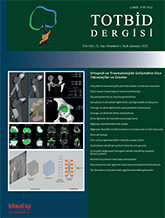
Total hip replacement is the most commonly performed reconstructive hip surgery in adults. The main purposes of this surgical intervention are to eliminate pain by maintaining hip joint stability and to regain full range of motion. Surgical techniques, biomaterials and prosthetic designs evolve over time by adapting to each other. However, a wide variety of complications can occur after surgery, even can take place years later. Following the previous hip surgery, each subsequent surgical procedure significantly reduces the success rate. Therefore, it is essential to asses the patients who will undergo a primer total hip replacement very well and to perform pre-operative planning very carefully. Besides allowing the surgeon to assess the patient`s anatomy better, the robotic- arm-assisted total hip arthroplasty (THA) system also provides accurate placement of the components as planned preoperatively with the help of the computerized tomography. Additionally, this system gained an increasing interest and popularity in recent years, providing the optimal leg length difference and soft tissue balance and improving patient satisfaction.